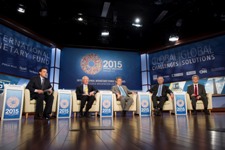
Typical street scene in Santa Ana, El Salvador. (Photo: iStock)
IMF Survey : The Elusive Pursuit of Inflation
April 17, 2015
- Weak demand culprit for low inflation in advanced economies, panelists say
- Signs that unconventional monetary policy is working
- Emerging markets need smart policies and robust economies to withstand spillover effects
Having worked for years to tame inflation, the world’s central banks are now facing an increasing challenge to reawaken it. In a Spring Meetings seminar, top economists discussed the causes of low inflation, the tools to raise it and implications for global currency movements.

IMF-World Bank Spring Meetings, Washington, DC. Seminar panelists discuss the domestic and global factors working against the goals of central banks around the world (photo: IMF)
SPRING MEETINGS PROGRAM OF SEMINARS
With core inflation in Europe, Japan, and the United States well below their target levels, two out of three central banks are currently expanding quantitative easing and one is signaling a slower exit.
Top economists discussed the causes of low inflation, the tools to raise it and the implications for global currency movements in a seminar on “The Elusive Pursuit of Inflation” at the IMF-World Bank Spring Meetings.
Diagnosis and prognosis
Demand is weak at the global level and output is well below potential in major advanced economies. But the panelists saw reasons for optimism. They expected Europe, Japan, and the United States to make progress over the course of this year and the next.
In the United States, the inflation rate had been rising before the drop in energy prices had a “massive but temporary effect”, according to Stanley Fischer, Vice-Chair of the Federal Reserve Board. Amid signs that wages are increasing, he said he expected the U.S. to move towards 2 percent inflation over the next couple of years.
David Lipton, First Deputy Managing Director of the IMF, noted that the U.S. economy was on the upturn and said lower energy prices would have a positive effect on spending in Europe. “The risk of a prolonged deflationary episode is diminished,” he said, while advising caution.
Peter Praet, member of the European Central Bank’s Executive Board, agreed that the output gap was closing but regretted that the opposite was happening in many emerging markets. He noted that a sequence of shocks on the supply side had made for a difficult analysis.
It takes a “big push” to escape a deflation trap, according to Takatoshi Ito, Professor at Columbia University. After 15 years of deflation and low expectations in Japan, it was a “significant achievement” to raise inflation from −0.5 percent in 2013 to 1.5 percent in 2014. Inflation has since slipped back to zero. In his view this is largely due to the fall in energy prices, rather than a failure of monetary policy.
Monetary policy working, more action needed
All panelists spoke positively of the effects of unconventional monetary policy: quantitative easing and accompanying measures. None saw current policies as presenting a significant risk to financial stability. They argued that in any case, macro-prudential policies were a more precise tool to address financial risks, should they arise.
The panelists agreed that strong measures by central banks were fully justified by economic conditions. Peter Praet emphasized the ECB’s commitment to pursue quantitative easing at least until September 2016. And David Lipton noted the vital role that such commitment could play in anchoring expectations: “to do whatever it takes, for as long as it takes”, as he put it.
But there are limits to what monetary policy can do. Central banks are, quite appropriately, focused on fulfilling their price stability mandate. Panelists pointed out that in the meantime there are many supporting actions that governments can take. Current conditions in many countries present a unique opportunity to invest in infrastructure, thereby enhancing productivity. Governments should also be facilitating balance sheet repair by banks, firms and households.
2 percent or not 2 percent: that is the question
The United States, euro area, and Japan are all aiming towards inflation approaching 2 percent. Some economists have argued that the target should be significantly higher, for example around 4 percent. But this view was not shared by any of the panelists, who recommended focusing on the already challenging task of reaching 2 percent.
Spillovers to emerging economies
Dealing with spillovers from macroeconomic policies in advanced economies is nothing new for emerging economies, said Takatoshi Ito. The unusual feature of recent spillovers is that they are perceived to arise almost exclusively from currency movements. Quantitative easing can be a strong driver of capital inflows to emerging economies, while an exit from such policies can cause flows to change direction. Emerging markets need to build more robust economies and deploy “creative policies” to withstand exchange rate fluctuations, he added.
Stanley Fischer emphasized that the Fed had been scrupulous about signaling likely future interest rate actions, so that other countries have had ample time to prepare. Besides, such actions would be incremental. “We are not talking about going from light to darkness,” he said. He agreed with Mr. Ito that spillovers to other countries could be mitigated by smart policies.


